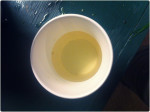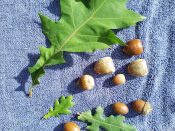Ox-Eye Daisies (also spelled “oxeye” daisy) are an abundant wild edible that thrives in fields, meadows, and other disturbed areas. It is a familiar plant with a sun-yellow central disc and spreading white ray florets, found in backyards, parks, and out in the wild.
Ox-eye daisies are edible: the leaves make a nice (but somewhat bitter) addition to salads, and the flowers can be eaten raw, added to dishes for decoration, pickled like capers, or cooked in a variety of ways.
While we can add the flower heads to a salad, there are, in my opinion, tastier ways to enjoy these flowers. I think most people enjoy a good fried food, and these daisies make perfect flower fritters.
Ox-eye daisies have a slightly sweet, slightly peppery taste that is a great addition to any meal, whether at home or in the backcountry.
When harvesting, be sure to keep the tenets of Honorable Harvesting in mind, then enjoy your ox-eye daisy fritters in any of the following ways:
Recipe #1: Standard Ox-Eye Daisy Fritter s
s
Ox-Eye Daisy flower tops (leave some stem), rinsed and dried
1 cup Flour * Buckwheat or gluten free options will work too
1 cup Milk
1 Egg
Butter or organic Olive Oil
Directions:
In a bowl, combine the flour with the milk and egg, and mix until it is a fairly smooth consistency.
Heat the butter or olive oil in a cast iron skillet.
Dip the heads of the Ox-Eye Daisies into the batter and place face down (stem side up) in the skillet. Let fry until crispy golden, then remove from heat and place on a towel to remove excess oil. Let cool and enjoy.
Recipe #2: Sweet Daisy Fritters
Ox Eye-Daisy flower heads, rinsed and dried
1 cup Pancake Mix *gluten free pancake mix will work too
1 cup Milk
Sugar, maple syrup, or honey
Vanilla extract
Cinnamon
Butter or organic Olive Oil
Directions:
In a bowl, combine the pancake mix with the milk, sugar/sweetener, vanilla, and cinnamon and mix until it is a fairly smooth consistency.
Heat the butter or olive oil in a cast iron skillet.
Dip the heads of the Ox-Eye Daisies into the batter and place face down (stem side up) in the skillet. Let fry until crispy golden. If you wish, you can sprinkle a little more sweetener on to the daisies to help them caramelize in the pan. Next, remove from heat and place on a towel to remove excess oil. Let cool and enjoy.
Recipe #3: Savory Ox-Eye Fritters
Ox-Eye Daisy Heads, rinsed and dried
Butter
Salt
Pepper
Herbs — such as rosemary, thyme, or basil
If you are really adventurous you can add in some red pepper flakes or a pinch of cayenne
Directions:
Heat the butter or olive oil in a cast iron skillet, as the daisies cook you may need to add more.
Place the daisies face down (stem side up) in the skillet. Sprinkle the herbs, salt and pepper in and let fry until crispy golden.
Remove from heat and place on a towel to remove excess oil. Let cool and enjoy.
For more wild edible recipes, check out these other Wolf College guides:
- Tips for Eating Edible Insects
- Eating From The Seashore: Seaweeds & Shellfish of the Salish Sea
- How to Cook over a Campfire
- Filbert / Hazelnut Milk & Truffle Dessert Recipes
- Stinging Nettle: Harvesting, Processing and Recipes
- Cattail Chips
- Making Healthy Natural Miso Soup with Kombu Kelp Seaweed
Happy Harvesting!
Learn how to confidently identify plants using their unique family patterns in this in-depth video by author of Botany in a Day, Thomas Elpel!
*** For educational purposes only. This information has not been evaluated by the Food and Drug Administration. This information is not intended to diagnose, treat, cure or prevent any disease. We recommend that you consult with a qualified health care practitioner before using herbal products, particularly if you are pregnant, nursing or on any medications. ***
*** Please read our Honorable Harvesting Guidelines before harvesting any plant material. The final guideline is of utmost importance: “Never put anything in your mouth unless you are 100% sure it is safe to ingest.” ***
Hannah began her apprenticeship at Wolf Camp in 2013 and graduated as a lead herbal instructor in 2014. Join Hannah and other Wolf College wild chefs during our annual Wild Cooking & Ethnobotany Expedition: The Herbal Foray the second week of July on Lake Sammamish near Seattle.
Hannah graduated from the University of Oregon in 2014 with a Bachelor’s Degree in Foreign Languages. She has her own blog, where she writes about her love for crafts, animals, plants, cooking, and the outdoors: rainmountaincrafts.com













